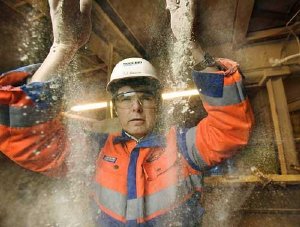The cement used in Oslo's new Bjørvika tunnel kept 8,000 tonnes of CO2 from entering the environment -- the equivalent of 60 million vehicle trips through the tunnel. The more environment-friendly concrete is the result of intensive research collaboration.
 Terje Rønning, R&D Manager at cement producer Norcem and chairman of the board of the Concrete Innovation Centre (COIN). (Credit: Sverre Jarild)
Terje Rønning, R&D Manager at cement producer Norcem and chairman of the board of the Concrete Innovation Centre (COIN). (Credit: Sverre Jarild)
The Norwegian concrete industry won worldwide acclaim for its gigantic North Sea constructions. Its best-known achievement was the Troll A platform in 1995 -- the largest structure ever moved by man.
Today the concrete industry is orchestrating new achievements on the environmental front.
"We need to be proactive," says Terje Rønning, R&D Manager at cement producer Norcem and chairman of the board of the Concrete Innovation Centre (COIN). Dr Rønning freely admits that environmentally speaking, concrete often falls short in comparison with other building materials. Thus, COIN intends to become no less than the European leader in research on concrete. The centre has been granted status and funding as one of the 14 Centres for Research-based Innovation under the Research Council.
Turning waste into a resource
Researchers and the industry are attacking the environmental challenge in two ways. One is by substituting CO2-neutral fuel for the coal and oil used in cement kilns. The other is by replacing some of the limestone (calcium carbonate or CaCO2), which is the primary raw material in cement production, with other raw materials that do not emit CO2.
"We have launched a new cement product, specially intended for civil engineering structures, in which 20 per cent of the Portland clinker is replaced by fly ash, a combustion residue generated at coal-fired power plants that does not emit CO2," explains Knut O. Kjellsen, Chief Engineer at Norcem.
"This residue material is not only more environment-friendly, it also has properties that prevent cracking and protect against penetration by seawater and road salt."